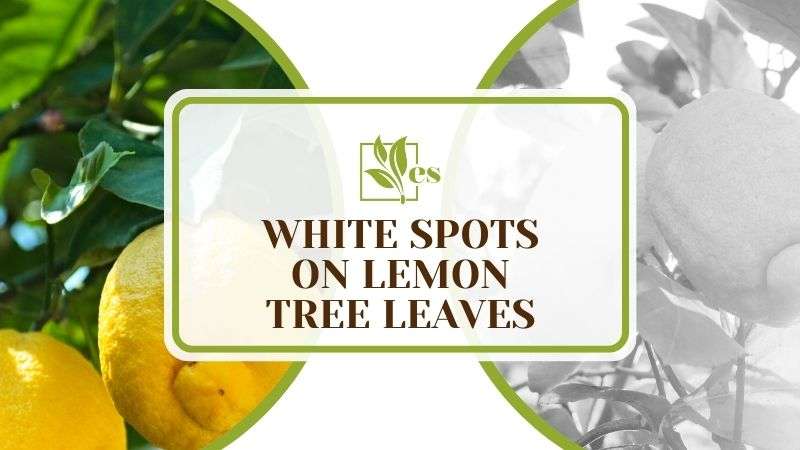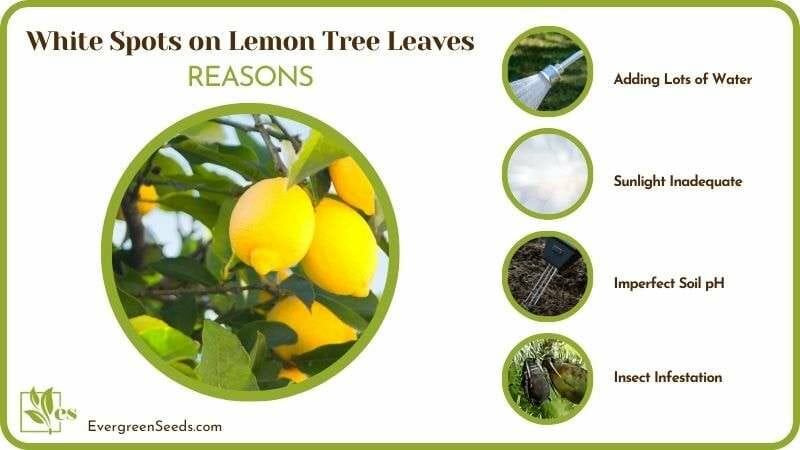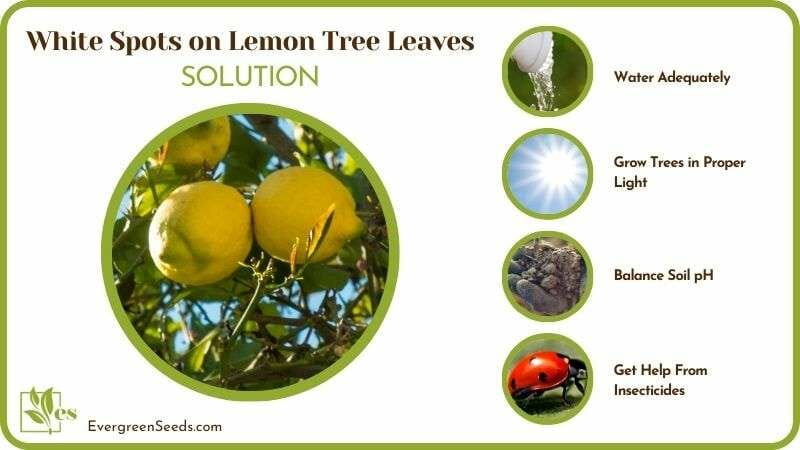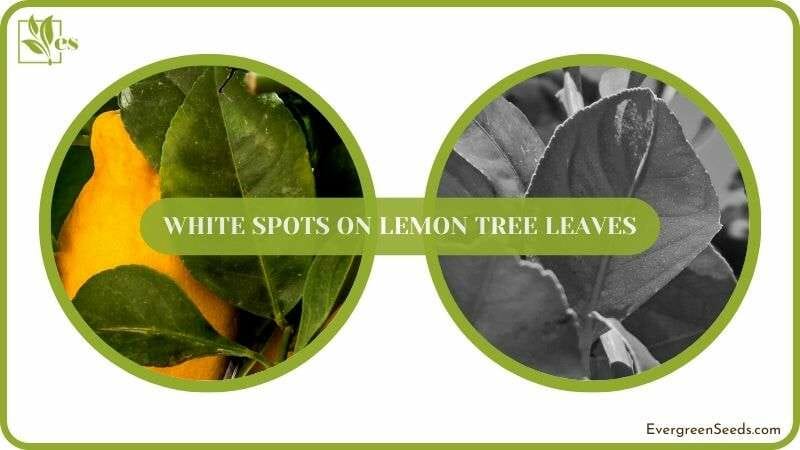White spots on lemon tree leaves occur for several reasons, like overwatering, light stress, imbalance in soil pH, insect infestation, and diseases.

Luckily, this condition is curable if you follow specific practices such as water correctly and balancing the soil pH.
If you want to know about them and the explanation of these causes, then stick to the end.
What Causes White Spots on Lemon Tree Leaves?
White spots on lemon leaves are caused due to improper watering, high or low light exposure, nutrient deficiency, insect attack, and bacterial/fungal diseases. Trees might face a combination of different reasons when you see white dots on them, so take that into account when deciding on a remedy.
– Adding Lots of Water
An excess of anything is bad, and water is no exception. Trees indeed need water for smooth physiological functions. But if you apply more than required, no good will happen. One negative effect caused by overwatering is white blotches or spots on leaves.
When you saturate the soil with water, the oxygen supply will get limited. This will impact root functioning. As a result, nutrient and water absorption won’t take place properly, which will cause white patches on the leaves.
Furthermore, root rot will also occur if you add too much water. It is a disease in which roots begin to “rot,” and cannot absorb anything. That is why trees become weaker, and you also see the impact on leaf health.
Adding more water is one of many reasons that causes overwatered or saturated conditions. If the type of soil is compact and drainage is poor, moisture will stay around the roots for a long time, affecting nutrient and water uptake.
– Sunlight Inadequate
Fruit trees can’t grow without light. They get energy from the light rays, which they use for growth, flower, and fruit production. Lemon trees require six to eight hours of light for smooth vegetative and floral growth. But if they receive too much of it, then problems occur.
When you leave trees exposed to high-intensity light, sunburn or leaf scorching occurs. In this, the leaf cells start to die, which causes white or discolored spots. That’s not all. Leaves also start to lose moisture due to heat stress. When this happens, photosynthesis cannot take place as usual. As a result, leaves start having spots and eventually curl up.
Like overexposure, trees receiving insufficient light or growing in shade also face problems. This is because low light means a low photosynthesis rate. So, trees will need more food/energy for trees in this situation. When this happens, leaves will become weak, have spots on them, and maybe start to lose them.

– Imperfect Soil pH
Lemon plant grows slightly acidic to neutral soils with a pH of 6.0-7.0. If soils are lower or higher in pH, then roots won’t be able to absorb the vital nutrients. This will make trees nutrient deficient, and the condition will ultimately lead to white spots emergence.
To know the pH, you can do different things. The easiest methods are using a pH meter and pH measuring strips. You can also send the soil sample to a lab and have it tested to know about pH and nutrient deficiencies.
– Insect Infestation
When you see white dots or spots on leaves, then check for insect infestation. For this, closely observe the underside of leaves and whole stems. Furthermore, if you see sooty mold, it means insects are nearby. Let’s look at which insects love to feast on citrus trees, including lemon.
Spider mites are common lemon tree insects. They suck the sap, which causes small dot-like spots to emerge. To check if there is a mite infestation, take a good look at the tree. If you see webbing, then know that mites have attacked it.
Another insect that can be seen around lemons is leaf miner. It resides inside the leaves by making a mine, causing them to curl and ultimately fall off. This insect loves feeding on younger, tender leaves (not old ones). When its infestation is not severe, you will only see white, yellow, or brown spots on citrus leaves. However, more of them can cause drooping of leaves.
– Fungal and Bacterial Diseases
The most common lemon disease is powdery mildew which causes white marks. The white marks or spots are, in fact, coatings that also harm different parts. In this disease, you will also see white fungus on lemon tree trunks, fruits, and leaves. In addition to powdery mildew, citrus scab is another fungal disease that impacts leaves and fruit’s quality.
These lemon tree white fungus diseases occur in poorly ventilated and high-humidity areas. You can only do a little about humidity, but you should ensure ventilation as much as possible. Keep the canopy thick, and cut the extra parts for better aeration.
Moreover, citrus canker is a bacterial infection that causes cankers (swollen/sunken areas), spots on leaves, and fruit scabbing. That’s all about common lemon or citrus tree diseases. Now, let’s look at what you can do to fix the white blotches or spots.
How To Treat White Spots on Lemon Leaves?
To treat of white spots on lemon leaves, you should water appropriately, prune off extra shoots to improve light passage, balance soil pH, apply insecticides, and use fungicide or bactericide (depending on the disease). Keep the garden clean and remove any infected parts to avoid further complications.
– Water Adequately
The first thing to do when you notice abnormal leaf conditions is to check soil condition and whether it is too dry or overly moist. For this, you can either use your fingers to sense moisture or a moisture meter. If the soil is moisture-less, apply water carefully. Make sure you only add sufficient water that moistens the root ball. Applying less or more can lead to different problems.
You should also improve soil drainage if you want your trees to avoid watering stress. Try adding organic matter such as compost or peat moss to the soil. This will increase drainage by breaking larger clumps. Adding 2 inches of compost or peat moss improves soil condition.
– Grow Trees in Proper Light
Citrus trees (including lemon) need more than six hours of sunlight for proper growth. Therefore, you must grow them where they get sufficient indirect sunlight. Furthermore, the upper part sometimes gets too big, which casts shade on the lower leaves.
It would be best if you also pruned branches that block the sunlight. Doing this will also increase airflow and prevent the disease from spreading.

– Balance Soil pH
If the pH is below 6.0, apply alkaline compounds like lime, wood ash, kiln dust, etc. If it is above 7.0, add acidic compounds like sulfate, sulfur, sphagnum peat moss, etc., to bring the pH to the ideal range.
– Get Help From Insecticides
Apply insecticides when you see lots of insects around and on lemon leaves. First, try organic repellents like neem oil spray, insecticidal soap, etc., to eliminate all the insects. You can also use natural predators, like green lacewings, ladybugs, and wasps, to get the population under control.
Using companion plants like caraway, fennel, and tansy is another good option. If you still see insects, then go for chemical insecticide sprays. Keep them as a last option because chemicals in them can also damage your health if you are not careful with the application. You should apply them in controlled amounts while wearing gloves, goggles, and a mask.
– Deal With Diseases
If diseases have attacked trees, remove the affected parts and dispose of them safely far from the trees. Next, you should prune the extra shoots and leaves to improve aeration (which can control fungal attacks). Also, keep your garden clean to avoid bacteria and fungus buildup.
In addition to these things, you should also apply bactericides and fungicides according to the disease. Make sure to follow precautions and dosage instructions when you apply them to cure diseases. After this, make a habit of applying water in a controlled amount to prevent the re-occurrence of diseases.













